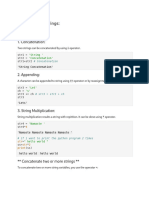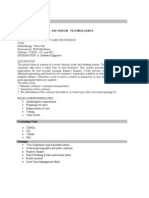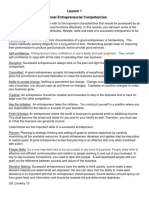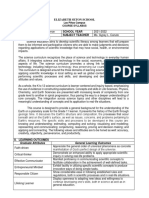Python Week 3
Uploaded by
Divyanshu Singh SisodiyaPython Week 3
Uploaded by
Divyanshu Singh SisodiyaPython Programming-20CS31P
WEEK -3
Control flow: The program instructions are executed sequentially i.e, one after the
Control Flow: after.
Conditional • If you want to skip some instructions or you want to change the flow of the
blocks program, it is done by conditional blocks.
Conditional blocks / statements in Python are
• if statement
• elif statement
• else statement
• Nested if
• The comparison operators such as ==, !=, > Ex: a=30
if statement , <, <=,>= are used to form conditions. b=20
• Ex: a == b, a != b, a < b, a > b etc.. if a > b:
• These conditions are used in if statement. print(“a is greater than b”)
In the above example
• if is keyword
• a>b is the condition to be tested
How if works?
• if the condition a>b is true, then the statement print(“a is greater than b”) is
executed .
• if the condition a>b is false, then the statement print(“a is greater than b”) is not
executed .
General format
if condition:
Statement/ block of statements
Statement
• if the condition is true, then the Statement/ block of statements are executed .
• if the condition is false, then the Statement/ block of statements are skipped and
statement after the if block is executed.
Ex: n1=30
n2=20
if n1 > n2:
print(“n1 is greater than n2”)
Ex: if 5 == 5
print(“both are equal”)
Ex: n1=30 , n2=20
if n1 != n2:
print(“n1 is not equal to n2”)
SHESHADRI A V, DEPT OF CSE, GPT CHN Page 1
Python Programming-20CS31P
• elif statement is used to test another Ex: n1=10
elif statement condition, when the previous if statement n2=10
is false. if n1 > n2:
General format print(“n1 is greater than n2”)
if condition1: elif n1 == n1:
statement 1 print(“n1 is equal to n2”)
elif condition2:
statement 2
else statement • else statement is used when all the Ex: n1=10
previous conditions are false. n2=20
General format if n1 > n2:
if condition: print(“n1 is greater than n2”)
statement1 else:
else: print(“n2 is greater that n1”)
statement 2
Nested if • Placing an if statement inside Ex: x=31
statement another if is called nested if. if x > 10:
print(“x is greater than 10”)
if x > 20:
print(“x is greater than 20”)
if x > 20:
print(“x is greater than 30”)
• The and keyword is a logical Ex: a=200 b=33 c=500
And operator, and is used to combine if a > b and c > a:
conditional statements. print(“both conditions are true”)
Or • The or keyword is a logical Ex: a=200 b=33 c=500
operator, and is used to combine if a > b or a > c:
conditional statements. print(“at least one of the condition is
true”)
• if statements cannot be empty. Ex: a=33
Pass • But due to some reasons, if you b=200
statement have an if statement with no if b > a:
content, put it in the pass statement pass
to avoid getting an error.
SHESHADRI A V, DEPT OF CSE, GPT CHN Page 2
Python Programming-20CS31P
Sample Programs
# Python program to demonstrate if statement
a=30
b=20
if a > b:
print(“a is greater than b”)
# Python program to demonstrate if and elif statement
n1=10
n2=10
if n1 > n2:
print(“n1 is greater than n2”)
elif n1 == n1:
print(“n1 is equal to n2”)
# Python program to find largest of two numbers
a=30
b=20
if a > b:
print(“ a is greater than b”)
else:
print(“ b is greater than a”)
# Python program to find largest of three numbers
a = int(input(“Enter the value of a:”))
b = int(input(“Enter the value of b:”))
c = int(input(“Enter the value of c:”))
if a > b and a > c:
print(“a is largest”)
elif b > c:
print(“b is largest”)
else:
print(“c is largest”)
# Python program to illustrate nested if
x=31
if x > 10 and x < 20:
print(“x is greater than 10”)
if x > 20 and x <30:
print(“x is greater than 20”)
SHESHADRI A V, DEPT OF CSE, GPT CHN Page 3
Python Programming-20CS31P
if x > 30:
print(“x is greater than 30”)
# Python program to illustrate pass statement
a=33
b=200
if b > a:
pass
print("if statement is passed")
SHESHADRI A V, DEPT OF CSE, GPT CHN Page 4
You might also like
- Grade 6 - Handout On Python Programming 2023-24No ratings yetGrade 6 - Handout On Python Programming 2023-2412 pages
- Unit 1 Control Structures-Python for StdsNo ratings yetUnit 1 Control Structures-Python for Stds18 pages
- Class IX Robotics(Introduction to Data - Programming with Python) Lesson 4 Conditional Statements Session 2024--25No ratings yetClass IX Robotics(Introduction to Data - Programming with Python) Lesson 4 Conditional Statements Session 2024--254 pages
- Day4-Facilitation Guide(Conditional Constructs)No ratings yetDay4-Facilitation Guide(Conditional Constructs)11 pages
- 11 Computer Science-Python Conditional Statements-NotesNo ratings yet11 Computer Science-Python Conditional Statements-Notes16 pages
- CH 6 FLOW OF CONTROL-Conditional StatementsNo ratings yetCH 6 FLOW OF CONTROL-Conditional Statements8 pages
- Quick Start Owner's Manual: Professional DJ MixerNo ratings yetQuick Start Owner's Manual: Professional DJ Mixer28 pages
- 1st Quarter, 1st Sem - g11 Stem e - Literature, OcNo ratings yet1st Quarter, 1st Sem - g11 Stem e - Literature, Oc3 pages
- Chapter 3: Organizational Objectives, Growth and ScaleNo ratings yetChapter 3: Organizational Objectives, Growth and Scale25 pages
- Passaic Boys Are Hell: Robert Smithson's Tag As Temporal and Spatial Marker of The Geographical SelfNo ratings yetPassaic Boys Are Hell: Robert Smithson's Tag As Temporal and Spatial Marker of The Geographical Self14 pages
- Psim Mathematical Tools To Simulate Pem Fuel Cells Including The Power Converter PDFNo ratings yetPsim Mathematical Tools To Simulate Pem Fuel Cells Including The Power Converter PDF6 pages
- Managerial Economics & Business Strategy: Managing in Competitive, Monopolistic, and Monopolistically Competitive MarketsNo ratings yetManagerial Economics & Business Strategy: Managing in Competitive, Monopolistic, and Monopolistically Competitive Markets46 pages
- Topic 21 Polymerisation - CIE Chemistry A-LevelNo ratings yetTopic 21 Polymerisation - CIE Chemistry A-Level85 pages
- Matrix Structural Analysis Second Edition William Mcguire download100% (1)Matrix Structural Analysis Second Edition William Mcguire download62 pages
- Cub Cadet Parts Manual For Model 46f 4x4 Utility Vehicle Efi100% (40)Cub Cadet Parts Manual For Model 46f 4x4 Utility Vehicle Efi8 pages
- Lesson 1 Personal Entrepreneurial CompetenciesNo ratings yetLesson 1 Personal Entrepreneurial Competencies1 page
- Pathology -Dr.Priyanka Sachdev - (17 Oct 23)No ratings yetPathology -Dr.Priyanka Sachdev - (17 Oct 23)188 pages
- Alert Service Bulletin: ASB MBB-BK117 C-2-62A-007No ratings yetAlert Service Bulletin: ASB MBB-BK117 C-2-62A-00716 pages
- Endo_Practical_Tissue fixation, embedding in paraffin, microtomy and slide preparation_5HNo ratings yetEndo_Practical_Tissue fixation, embedding in paraffin, microtomy and slide preparation_5H4 pages

























































































